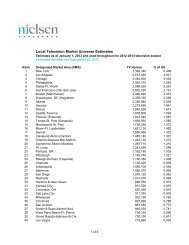TV Basics Online - Television Bureau of Advertising
TV Basics Online - Television Bureau of Advertising
TV Basics Online - Television Bureau of Advertising
You also want an ePaper? Increase the reach of your titles
YUMPU automatically turns print PDFs into web optimized ePapers that Google loves.
<strong>TV</strong> <strong>Basics</strong><br />
Piggyback<br />
The back-to-back scheduling <strong>of</strong> two or more brand commercials <strong>of</strong><br />
one advertiser in network or spot positions.<br />
Pod<br />
A group <strong>of</strong> commercials, promos or announcements contained in a television<br />
program break.<br />
Post Buy Analysis<br />
An analysis <strong>of</strong> schedule performance after it runs; <strong>of</strong>fers a means <strong>of</strong><br />
measuring a media buy as run versus its goal or original estimate <strong>of</strong><br />
achievement.<br />
Pre-emption<br />
An omission <strong>of</strong> an announcement from a previously confirmed broadcast<br />
schedule; the advertiser is either <strong>of</strong>fered a make-good or takes a credit.<br />
Psychographics<br />
Audience analysis on the basis <strong>of</strong> psychological factors such as lifestyles,<br />
values and interests and how they affect purchase behavior.<br />
Q<br />
Quarter Hour Audience<br />
Individuals viewing a station at least five minutes in a specific 15-minute<br />
period.<br />
R<br />
Rating<br />
A percentage <strong>of</strong> total households or population owning <strong>TV</strong>s who are<br />
tuned to a particular program or station at a specific time (e.g., a six<br />
rating for women 18-49 means 6 percent <strong>of</strong> all women 18-49 in the<br />
defined geographic area were viewing that station or program).<br />
Rating Point<br />
A value equal to one percent <strong>of</strong> a population or universe.<br />
Reach<br />
The number <strong>of</strong> unduplicated households or people exposed to a program,<br />
group <strong>of</strong> programs or an advertiser’s schedule over a specific time period.<br />
Reach x Frequency = Gross Rating Points<br />
Rep Firm<br />
Media sales representation company with <strong>of</strong>fices in major advertising centers<br />
which represents stations in various markets for national<br />
advertising sales.<br />
Rotation<br />
Scheduling <strong>of</strong> advertising in the same program or time period on different<br />
days each week (horizontal rotation) or throughout a particular day (vertical<br />
rotation) in order to increase advertising exposure to different<br />
prospects.<br />
Run-Of-Schedule (ROS)<br />
Scheduling <strong>of</strong> commercials at any time <strong>of</strong> a station’s choosing.<br />
43<br />
Road Blocking<br />
The scheduling <strong>of</strong> a brand’s commercial at approximately the same<br />
time on all networks, or all stations in a given market.<br />
S<br />
Satellite Station<br />
A station that has agreed to rebroadcast the transmission <strong>of</strong> another<br />
station (generally operating in a larger nearby market) to an area that<br />
cannot otherwise be served by that station.<br />
Saturation<br />
The concentration <strong>of</strong> a heavy amount <strong>of</strong> advertising in a short period<br />
<strong>of</strong> time in order to attain maximum reach.<br />
Scatter Plan<br />
Scheduling method where the advertiser’s commercials are rotated among<br />
a broadly described group <strong>of</strong> programs and/or time periods.<br />
The advantage is that the advertiser gains a greater net audience (reach);<br />
the disadvantage may be that the station may include less attractive<br />
spots/commercial units in the schedule.<br />
Schedule<br />
A listing <strong>of</strong> the time <strong>of</strong> day and dates an advertiser’s commercials<br />
are planned to run.<br />
Set-top box (STB)<br />
These receivers (named because they typically sit on top <strong>of</strong> a television<br />
set) convert and display broadcasts from one frequency or type – analog<br />
cable, digital cable, or digital television – to a standard frequency<br />
(typically channel 3 or 4) for display on a standard analog television set.<br />
Share<br />
The percent <strong>of</strong> households (or persons) using television who are tuned to<br />
a specific program, network, or station at a specific time.<br />
Spill-In<br />
The penetration <strong>of</strong> a television signal transmitted from outside the<br />
market area.<br />
Spill-Out<br />
The transmission <strong>of</strong> a television signal beyond its own market area.<br />
Sponsorship<br />
The purchase <strong>of</strong> all or part <strong>of</strong> a television program by one advertiser.<br />
Spot <strong>TV</strong><br />
The advertising time purchased from individual stations. There are two<br />
major types: local and national. Local spots are purchased in one market<br />
and aimed only at the audience in that particular market. National spots<br />
are bought by national advertisers in several markets.





